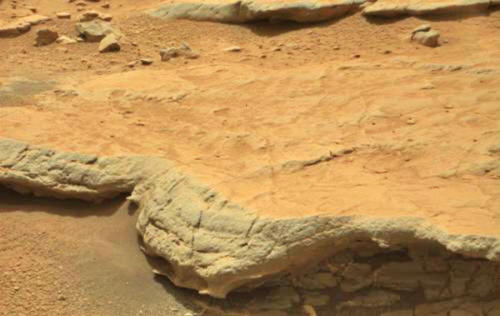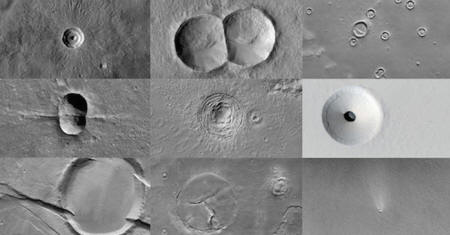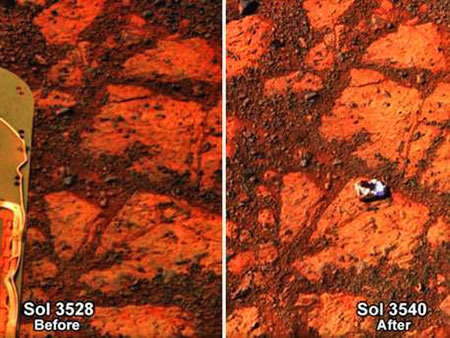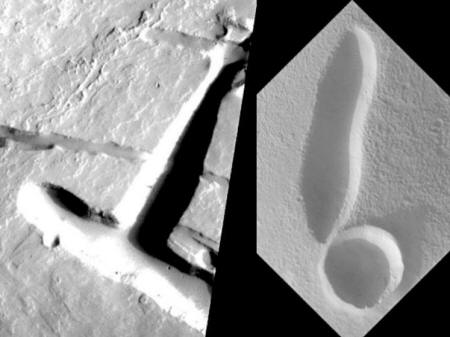|

by Buck Rogers
January 12, 2015
from
WakingTimes Website
|
Buck Rogers is the earth bound incarnation of that familiar part of
our timeless cosmic selves, the rebel within. He is a surfer of
ideals and meditates often on the promise of happiness in a world
battered by the angry seas of human thoughtlessness. |
Since time immemorial human beings have pondered the existence of
intelligent life in the universe, with a keen interest in our
neighboring planet.
The technological achievement of landing the Mars rovers on the
surface of the red planet is one of mankind's most incredible
accomplishments.
From the Opportunity, Spirit and Curiosity rovers,
plus numerous satellite missions, we have gathered many photographic
images and other data from the surface of Mars, and we now have an
exceptional view of it's some of its geologic features and makeup.
Recent photo analysis is recognizing that some of the rock features
are surprisingly similar to formations here on earth that were
shaped by living micro-organisms, opening up the possibility that
there is, or was, indeed life on Mars.
The
Mars Curiosity Rover took
photos of a formation on the surface of Mars called the
Gillespie
Lake outcrop, showing rock structures that are very similar to
microbially-induced sediment structures (MISS) found on Earth, which
in some cases have been dated to be up to 3.8 billion years old;
some of the oldest geologic formations found our planet.
In a recent paper (Ancient
Sedimentary Structures in the <3.7 Ga Gillespie Lake Member, Mars,
That Resemble Macroscopic Morphology, Spatial Associations, and
Temporal Succession in Terrestrial Microbialites) published in the journal Astrobiology, geo-biologist
Nora Noffke at Old Dominion University in Virginia compared these
sediments on Earth to those revealed in photos from the Curiosity,
noting the similarities between the formations, pointing to the
conclusion that at some time in the far distant past Mars must have
had colonies of microbes that went extinct at some point.
Her
analysis is a critical piece of the puzzle in putting together the
history of Mars.
"I've seen many papers that say 'Look, here's a pile of dirt on
Mars, and here's a pile of dirt on Earth,'" says Chris McKay, a
planetary scientist at NASA's Ames Research Center and an associate
editor of the journal Astrobiology.
"And because they look the same, the
same mechanism must have made each pile on the two planets.'"
McKay adds:
"That's an easy argument to make, and it's typically not
very convincing. However, Noffke's paper is the most carefully done
analysis of the sort that I've seen, which is why it's the first of
its kind published in Astrobiology."
[Source]

A rock bed at the Gillespie Lake outcrop on Mars
displays potential
signs of ancient microbial sedimentary structures.
Credit: NASA
Other Clues
This is only the most recent evidence that we've gathered which
points to the conclusion that Mars is, or at least at some point was,
a life-bearing planet.
This debate has heated up in the last couple of decades as NASA has
produced many provocative images of anomalous rock formations, as
well as detecting methane 'burps' on the planet, an organic chemical
that is produced by either biological or non-biological sources.
These puzzling spikes in methane emissions on Mars raise the
question of whether or not there are active plumes still emitting
gas that could be a by-product of water and organic life.
"NASA's Mars Curiosity rover has measured a tenfold spike in methane,
an organic chemical, in the atmosphere around it and detected other
organic molecules in a rock-powder sample collected by the robotic
laboratory's drill."
"This temporary increase in methane—sharply up and then back down—tells
us there must be some relatively localized source," said Sushil
Atreya of the University of Michigan, Ann Arbor, and Curiosity rover
science team. "There are many possible sources, biological or
non-biological, such as interaction of water and rock."
[Source]


Previous satellite observations have detected unusual plumes of
methane on the planet,
but none as extraordinary as the sudden
"venting" measured at Gale Crater,
where evidence suggests water
once flowed billions of years ago.
There is Water on Mars
NASA has also discovered water on Mars in the form of ice, and upon
examination of geologic information, is speculating that at one
point water was in free flowing abundance on the planet.
In 2014 the
Mars Reconnaissance Orbiter produced images that revealed "recurring
slope lineae," or dark flowing lines that appear to move down the
slopes of Martian mountains, indicating the former presence of an
abundance of water.
Photographic Anomalies
Additionally, many peculiar photos have been gathered that show
unusual structures including strange looking craters, geometric
shapes, pyramids, and other objects that appear to be artifacts or
ruins on the Martian planet, many of which look very 'alien' and
unlike any natural formations we see on planet earth.

Strange Craters on the Surface of Mars
Launched in 1975, NASA's Viking I spacecraft was the first vehicle
to land on the planet, taking startling images of rock formations on
the surface of Mars, the most famous of which, taken in Mars' Cydonia region, appears to be in the likeness of the human face.
Although controversial, for many this raises the question: is this
'face' a naturally occurring structure, or is it evidence of an
ancient civilization that once colonized the planet?

Viking I's 'Face on Mars'
In 2014, images from the Mars Opportunity Rover captured an
extraordinary anomaly when a rock, or some other object, appeared
out of nowhere.
Prior images of the same location just 4 days old
showed no such rock, and NASA has offered the explanation that the
rock was dislodged from a hilltop by the rover itself.

The so-called 'Jelly Donut Rock'
which appeared in 2014

'T-shaped' formations on the surface of Mars
Our Ancient Origins
So much of the history of the human race has been lost or hidden
from the masses, however, many independent thinkers and researchers
have posited that there was once a vibrant alien colony on the
planet, and that at some point something happened on Mars that
harshly altered its environment.
Physicist Dr. John Brandenburg
recently made headlines with his claim that geo-chemical samples
from the Martian planet reveal evidence of major nuclear fallout, a
result of a massive nuclear war, which was responsible for the
destruction of its biosphere and the ancient civilizations that
inhabited Cydonia and Utopia.
Puzzling Questions
The questions about the existence of life on Mars are puzzling both
scientists and journalists, yet with each new piece of data that is
recovered, the debate only grows.
Could it be that there once was an
advanced humanoid civilization on our neighboring planet, and that
Earth itself is in danger of suffering the same terrible fate which
laid waste to Mars?
Sources
|







